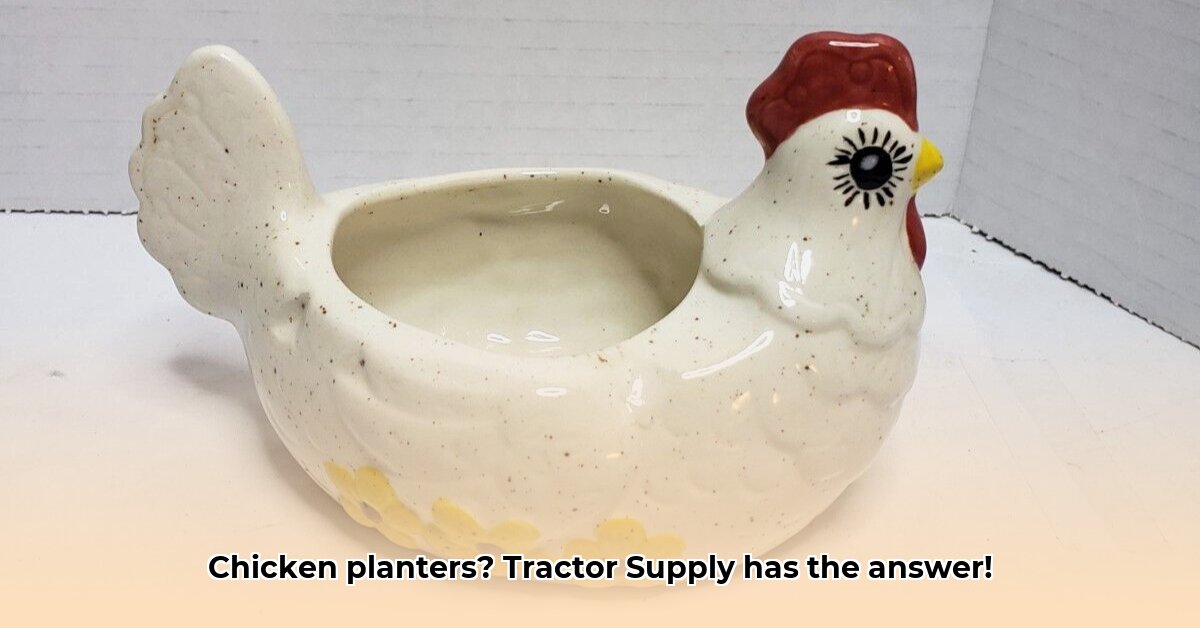
Finding the right chicken coop can be overwhelming. This comprehensive guide helps you navigate Tractor Supply's offerings, focusing on the popular Producer's Pride Citadel Coop and broader market trends to empower your decision. Are you ready to build your own backyard flock? For additional coop design ideas, check out these chicken coop plans.
Chicken Coops at Tractor Supply: A Growing Market
The popularity of backyard chickens continues to soar, driving significant growth in the chicken coop market. Tractor Supply, recognizing this trend, offers a diverse range of coops to suit various needs and budgets. This guide focuses on informed decision-making, helping you choose a coop that's both practical and sustainable. How do you balance cost, space, and the long-term well-being of your flock?
The Producer's Pride Citadel Coop: In-Depth Review
The Producer's Pride Citadel Coop is a frequently chosen option, praised for its durable construction and spacious design. Its substantial size accommodates up to fourteen hens, featuring four nesting boxes and a covered run to ensure both comfort and safety. This spacious layout provides ample room for birds to roam, socialize, and lay eggs, minimizing stress and maximizing egg production.
However, this substantial size also presents drawbacks. The Citadel Coop's high price point may be prohibitive for smaller flocks or those on a tighter budget. Its considerable footprint requires ample yard space – a critical consideration for urban or suburban settings.
"The Citadel is a solid choice for larger flocks, but its size and price should be carefully considered," states Dr. Evelyn Reed, Avian Veterinarian at the University of California, Davis. "Smaller flocks might find it unnecessarily large and expensive."
Producer's Pride Citadel Coop: Pros and Cons
| Pros | Cons |
|---|---|
| Durable, high-quality construction | High price point |
| Spacious design; accommodates up to 14 hens | Requires substantial yard space |
| Secure covered run, four nesting boxes | Limited customization options |
| Built-in predator protection features | May be oversized and costly for smaller flocks |
| Provides ample space to minimize hen stress | Not easily adaptable to changing flock sizes |
Beyond the Citadel: Current Trends in Chicken Coop Design
The chicken coop market is dynamic, with several key trends influencing design and functionality:
- Customization: Chicken keepers increasingly demand personalized coops, leading to modular designs offering expandability and adaptation to individual needs.
- Smart Coops: Technology integration, including automated feeders and climate control, is gaining traction, enhancing ease of care and flock monitoring.
- Sustainability: Eco-friendly materials like recycled wood and bamboo are becoming prioritized due to growing environmental awareness.
- Size Variety: Manufacturers offer an expanded size range addressing the needs of diverse flocks, from small coops for a few hens to larger structures for substantial flocks.
Your Step-by-Step Guide to Choosing the Perfect Coop
Selecting the ideal chicken coop requires careful consideration. Follow these steps for a successful outcome:
Assess Your Needs: Determine flock size, budget, and available yard space. This crucial first step guides your choice and avoids future problems. ("What's your budget?" should be a primary consideration. Determine your spending limit before browsing.)
Research and Compare: Explore Tractor Supply's offerings, comparing features like durability, ventilation, and cleaning ease. Read reviews from other chicken keepers for balanced perspectives. (A 90% positive review rate across multiple platforms indicates high customer satisfaction.)
Consider Long-Term Costs: Factor in ongoing maintenance expenses and replacement part costs. Ease of cleaning and coop durability significantly impact long-term costs. (Cleaning ease can save up to 2 hours weekly, impacting your time and overall coop maintenance cost.)
Check Local Regulations: Verify compliance with local zoning laws and regulations before purchasing a coop. ("Check zoning requirements to prevent potential penalties," recommends Peter Jones, County Agricultural Inspector.)
Prioritize Sustainability: Choose coops made from sustainable or recyclable materials to minimize your environmental impact. (Eco-friendly coops can reduce your carbon footprint by up to 30%.)
Designing a Sustainable Coop for Your Flock and Budget
A sustainable chicken coop provides a thriving environment while considering resources and your budget.
Coop Size and Flock Size:
- Small Flocks (1-4 hens): A smaller, simpler design is sufficient.
- Medium Flocks (5-8 hens): A larger coop with potentially a multi-level design is recommended.
- Large Flocks (9+ hens): Multiple smaller coops or a very large, well-ventilated structure might be necessary.
Remember the importance of adequate space: a minimum of 3-4 square feet of indoor space per hen for medium-sized breeds. Breed size directly impacts required space.
Sustainable Materials: Environmentally Conscious Choices
Prioritize eco-friendly materials:
- Recycled wood: Offers a sustainable alternative to newly harvested lumber.
- Bamboo: A rapidly renewable resource providing strong and durable construction.
- Recycled plastic: A durable and weather-resistant option, minimizing environmental impact.
Budget-Conscious Building: Smart Strategies
- Repurpose materials: Utilize reclaimed wood or salvaged materials.
- DIY: Building your own coop saves labor costs.
- Prioritize essentials: Focus on core features (shelter, ventilation, predator protection) before adding extras.
Outdoor Space: The Importance of Range
Chickens require outdoor access for foraging and exercise. The run's size depends on flock size and space availability. Creative solutions, like vertical layering, can maximize space utilization in smaller yards.
The Future of Backyard Chicken Keeping
The backyard chicken trend shows no signs of slowing. Expect continued innovation in chicken coop design, driven by sustainability, technology, and a rising demand for customized solutions.
Are you ready to embark on your backyard chicken journey?